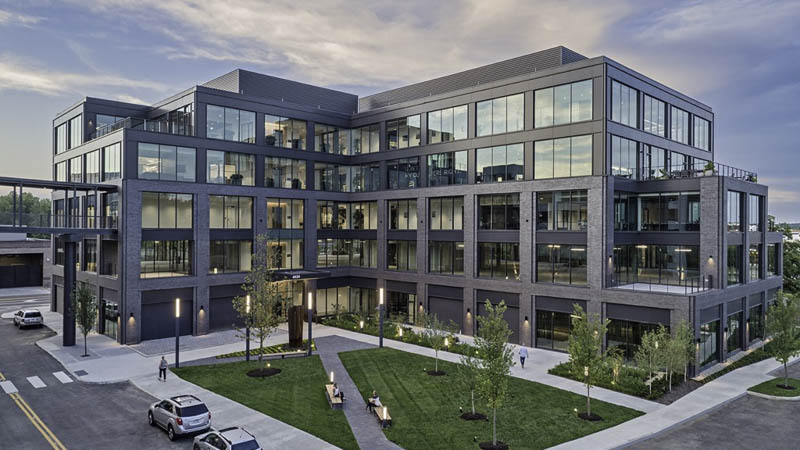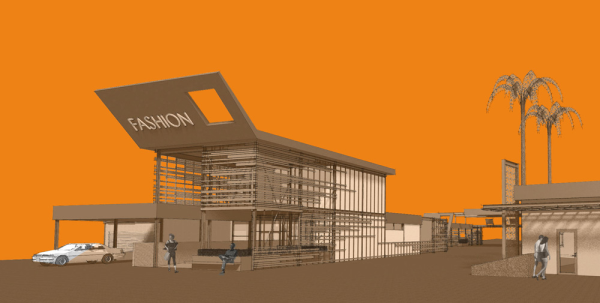Unveiling the Comprehensive Services Provided by Commercial Architects for Modern Dope
Commercial Architects serve an essential function in modern development projects. They mix style looks with capability while sticking to regulatory needs. Their experience extends past plain construction, incorporating sustainable techniques and innovative innovations. As they browse complicated zoning regulations, Architects work together with different stakeholders to bring visions to life. This diverse technique questions about the evolving role of Architects fit modern-day rooms and the influence of their service future developments.
Comprehending the Function of Commercial Architects in Modern Developments
In modern urban landscapes, Commercial Architects play a crucial duty in forming useful and visual areas that meet varied service demands. Their experience extends beyond mere design; they browse intricate zoning regulations, constructing codes, and ecological guidelines. By teaming up with customers, they determine details needs, making sure that each project aligns with the client's vision while likewise taking into consideration functional elements such as sustainability and cost-effectiveness. Commercial Architects are skilled at integrating ingenious innovations and products right into their layouts, improving both the performance and power performance of structures. They carry out comprehensive website analyses to assess the potential difficulties and opportunities offered by a location. In addition, efficient interaction with specialists and other stakeholders is crucial, making sure that the task advances smoothly from perception to conclusion. Eventually, Commercial Architects are crucial in creating rooms that not only satisfy practical functions however additionally add to the overall character and vibrancy of metropolitan settings.
Idea Layout: Transforming Ideas Into Truth
Concept style works as an important phase in Commercial design, where cutting-edge layout options emerge from innovative brainstorming. This procedure relies upon collaborative ideation, bringing together diverse perspectives to fine-tune and boost first ideas. As ideas take form, they transform from abstract notions into substantial architectural realities.
Cutting-edge Design Solutions
Changing ideas into reality is the trademark of innovative style options in Commercial architecture. These solutions mix creativity with functionality, dealing with the unique needs of modern-day advancements. By leveraging innovative innovations and sustainable practices, Architects craft spaces that are not just aesthetically attractive however additionally reliable and adaptable. Focus on customer experience drives the style procedure, ensuring that environments foster productivity and collaboration. Each task gain from a tailored method, where ideas are carefully developed to show the customer's vision while considering future patterns. Ingenious layout solutions likewise focus on versatility, enabling adjustments over time as service needs evolve. Eventually, these methods enhance the general worth of Commercial areas, making them crucial in today's competitive landscape.

Collective Ideation Process
Partnership functions as the foundation of the ideation procedure in Commercial style, cultivating creative thinking and development amongst varied stakeholders. Architects, customers, designers, and community participants take part in vibrant conversations, ensuring that all perspectives are thought about. This inclusive technique enables the exploration of various design principles, urging one-of-a-kind remedies that line up with the project's vision. Through workshops and brainstorming sessions, ideas evolve and improve, transforming preliminary ideas into tangible styles. Innovation additionally plays a critical role, with tools such as Structure Info Modeling (BIM) assisting in real-time partnership and modifications. Ultimately, this collective ideation process not only enhances the design result however likewise cultivates a sense of ownership and financial investment among all parties entailed, bring about successful Commercial developments.
Zoning Analysis: Browsing Laws and Conformity
As designers start on brand-new projects, understanding zoning laws is necessary to ensuring conformity and preventing costly delays. Zoning analysis plays an important role in this procedure, as it entails examining neighborhood zoning regulations that dictate land usage, constructing height, thickness, and troubles. Commercial Architects possess the know-how to browse these complex laws, assisting clients determine permissible usages and any type of essential differences.
Sustainable Design Practices: Structure for the Future
Lasting layout methods are significantly vital in the domain name of Commercial style, particularly as environmental worries remain to escalate. Architects focus on environmentally friendly materials, energy-efficient systems, and style techniques that lessen waste and ecological influence. Incorporating eco-friendly power resources, such as photovoltaic panels and wind turbines, allows structures to produce their own power and minimize dependence on fossil fuels.Furthermore, sustainable style stresses the significance of indoor environmental you can find out more high quality. This consists of using natural light, enhancing ventilation, and selecting safe products to boost owner health and wellness and productivity. Eco-friendly roofing systems and living walls are also popular features that add to biodiversity and city cooling.Additionally, Commercial Architects commonly incorporate water conservation techniques, like rain visit this web-site harvesting and drought-resistant landscaping. Via these innovative approaches, they develop areas that not only meet modern requirements but also foster a sustainable future, dealing with the expanding demand for accountable development in the contemporary world.
Task Administration: Ensuring Timely and Effective Implementation
Reliable job management is necessary for ensuring that Commercial design tasks are finished on time and within budget plan. This duty incorporates a variety of duties, including the coordination of numerous stakeholders, timelines, and resources. Commercial Architects utilize their proficiency to produce in-depth job strategies that describe critical turning points and deliverables, enabling systematic progress tracking.Regular interaction among employee and customers is important, cultivating openness and facilitating prompt decision-making. Threat management methods are additionally utilized to identify potential challenges early, enabling proactive services to be developed. By utilizing advanced task administration tools, Architects can keep an eye on project performance in real-time, making changes as needed to keep efficiency.
Interior Style: Creating Useful and Aesthetic Spaces
Interior style plays a vital duty in improving both capability and aesthetics within Commercial areas. Effective space preparation can maximize workflow and improve user experience, while visual design concepts contribute to a visually appealing setting - commercial architects. With each other, these aspects create spaces that are not only useful yet likewise inspiring
Space Preparation Performance
While making best use of the utility of readily available room, Commercial Architects focus on space planning efficiency to develop both practical and aesthetically pleasing settings. This approach entails cautious analysis of the spatial design to ensure perfect use every square foot. Architects take into consideration factors such as process, access, and all-natural light to improve usability. By tactically placing furniture, devices, and workstations, they facilitate motion and interaction among individuals, advertising productivity. Additionally, zoning different locations for certain functions assists in taking care of sound and privacy, developing a harmonious ambience. Through reliable room planning, Commercial Architects can change constraints into chances, making certain that each room meets the diverse needs of its residents while adhering to governing demands and sector criteria.
Visual Layout Concepts
Aesthetic layout concepts play an important role in forming settings that are not just useful yet likewise visually attractive. These principles guide Commercial Architects in creating spaces that reverberate with users while enhancing brand identification. Crucial element include balance, percentage, and harmony, which work together discover this to produce a cohesive look. Color design and products are carefully selected to evoke wanted emotions and support the overall theme. Furthermore, illumination plays an essential role, influencing state of mind and presence while highlighting building attributes. By incorporating these principles, Architects guarantee that spaces are not just practical however also inviting and motivating. Eventually, reliable visual layout cultivates a favorable individual experience, motivating engagement and complete satisfaction in Commercial settings.
Cooperation With Stakeholders: Promoting Effective Partnerships
Effective partnerships in Commercial style depend upon effective collaboration with stakeholders, ensuring that every voice is listened to and valued. This collective approach involves engaging numerous parties, consisting of clients, professionals, and community participants, throughout the layout and advancement process. By cultivating open communication, Commercial Architects can deal with concerns, collect insights, and straighten the project's vision with stakeholder expectations.The combination of varied point of views boosts creative thinking and technology, causing even more practical and aesthetically pleasing styles. Normal meetings, comments sessions, and workshops promote this discussion, enabling Architects to adjust their plans in action to stakeholder input. In addition, establishing trust fund through openness and accountability enhances these collaborations, leading to a smoother job execution.Ultimately, the success of modern-day developments depends on the Architects' capacity to browse and balance differing rate of interests, developing a joint setting that advertises common objectives and common success.
Frequently Asked Concerns
Exactly How Do Commercial Architects Take Care Of Budget Constraints Throughout a Project?

What Sorts of Software Application Do Commercial Architects Generally Utilize?
Commercial Architects generally use software such as AutoCAD for drafting, Revit for Structure Details Modeling, SketchUp for 3D modeling, and job monitoring tools like Microsoft Job to boost collaboration and enhance workflows throughout the style process.
Can Commercial Architects Help With Acquiring Funding for Projects?
Commercial Architects can help in acquiring funding for tasks by preparing in-depth propositions, aiding to express layout visions, and providing financial projections that can improve the probability of safeguarding essential financing from financiers or banks.
Just How Do Architects Make Sure Security Throughout the Construction Refine?
Architects guarantee security throughout building by executing extensive layout requirements, coordinating with engineers, performing normal site examinations, adhering to regional policies, and cultivating communication among all stakeholders to alleviate dangers and promote a secure functioning atmosphere.
What Continuous Support Do Architects Provide After Task Conclusion?
After job conclusion, Architects supply ongoing assistance with upkeep consultations, efficiency evaluations, and style modifications. They ensure buildings fulfill advancing demands, address possible concerns, and maintain conformity with laws, promoting a long-lasting relationship with customers.